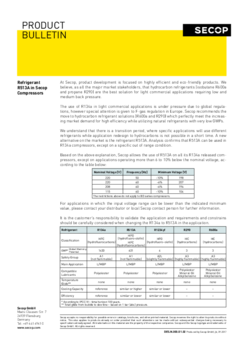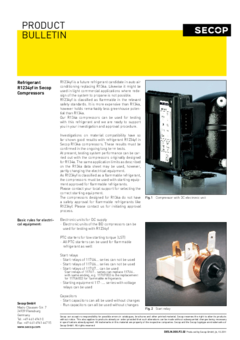Refrigerants – History, Bans, Natural and Synthetic Types
Summary of topics:
Summary of topics:
Refrigerants have been constantly evolving since their use in refrigeration appliances. Equipment modification, demands for an efficient solution and, in recent years, environmental and safety aspects have moved the development and use forward to new solutions.
In the beginning stages, the use of flammable and toxic fluids was present, but their dangers prevented their wider use. In the early 20th century, chemical non-flammable and low toxic refrigerants came into use and the era of CFCs and HCFCs was rung in. Later in the 1980s, the negative impact of chemical substances on the ozone layer was identified and their use was regulated by the Montreal Protocol. One such substance, chlorine, which is present in CFC and HCFC refrigerants, caused their phase down. Chemical companies identified HFCs as a replacement. While they do not deplete the ozone layer, HFC refrigerants have high global warming potential and contribute to greenhouse gases which can influence climate change.
This has been addressed more recently in 2016 by the Kigali Amendment by a gradual reduction of HFCs by 80–85% by 2050. All valid regulations and efforts for environment protection raised interest for refrigerants with low global warming potential (GWP) and ozone depletion potential (ODP). Among green refrigerants, the use of hydrocarbons (HC) and carbon dioxide (CO2) has increased sharply. Both mentioned have a long history of use since they were used in the early days of refrigeration. Their flammability is today very well covered by safety standards, with proper handling and, within a closed system, hydrocarbons have proven to be a safe alternative to previous refrigerant generations.
Refrigerant is a fluid that transfers heat in a refrigeration system and cools the contents. Based on the chemical composition, refrigerants are divided into groups:
Different chemical compositions have different impacts on the environment. Certain chemical substances present not only in refrigerants have been identified as harmful to the environment since they decompose the stratospheric ozone layer and create a greenhouse effect. Two properties, the Ozone Depletion Potential (ODP) and the Global Warming Potential (GWP) are the main two measurable categories for monitoring changes in the atmosphere and air quality.
GWP is the measure of a refrigerant’s ability to trap heat in the atmosphere over a given period compared to carbon dioxide. The higher value of GWP contributes to greater global warming.
ODP is the measure of a refrigerant’s ability to destroy ozone molecules in the upper atmosphere. The lower the ODP value, the less damaging the refrigerant is to the ozone layer.
A number of regulations came into force to eliminate the use of environmental hazardous substances and reduce total electrical energy consumption.
The Montreal Protocol, in force since 1987, is a global environmental agreement that regulates the production and consumption of chemicals responsible for ozone depletion. One of those, chlorine, present in the refrigerant groups CFC or HCFC, caused their phase down.
Hydrofluorocarbon refrigerants developed to replace stratospheric ozone-depleting substances CFC and HCFC have an ODP value of zero or close to zero. Although HFC’s do not harm the ozone layer, they have high global warming potential as they contribute to greenhouse gases which influence climate change. This fact was discovered after the Montreal Protocol was adopted and was recently covered by a Kigali Amendment in force since January 2019. Those countries that ratified the Kigali Amendment agreed on the gradual reduction of fluorinated greenhouse gases (HFCs).
With the prohibition of CFCs, HCFCs, and HFCs three possible choices in the refrigeration segment were left: HFC-HFO blends, HFOs, and natural refrigerants such as hydrocarbons (HCs).
Odorless compounds of hydrogen and carbon, occur naturally in the environment. Compared to synthetic refrigerants, they are environmentally friendly, harmless with zero ODP, and have a very low GWP. HCs operate at almost the same temperatures as HFCs and with a lower charge. Good thermodynamic and physical properties make HCs an energy-efficient solution. The downside is their flammability and higher demand for safety (safety class A3).
Secop has been an early adopter of hydrocarbons as a refrigerant and believes the most efficient and economical friendly substances for use in cooling appliances are isobutane (R600a) and propane (R290).
Due to cooling capacity limitations, R600a is recommended for use in smaller applications such as home refrigerators and freezers, minibars, and wine coolers. It is also applicable for mobile cooling use, including refrigerators and freezers for the automotive and maritime industries, cooling portable boxes, and products with solar and/or battery supply.
Refrigerant R290 with its efficiency is a good fit for light commercial appliances in food service and food retail, coolers, freezers, merchandisers, supermarket appliances as well as in the growing medical segment.
R600a and R290 with their efficiency and depending on the system design, require 40-50% smaller quantity of refrigerant compared to other refrigerants. Due to their flammability and explosive properties, the refrigerant volume is limited by standards and can vary from region to region. With proper precautions and care, there is no reason to worry about them. Minimal investments in components and design changes predestinate them for use in conventional cooling systems originally designed for HFCs.
(HFO), as HFCs, chemically consist of hydrogen, fluorine, and carbon but with a relatively low GWP and with zero impact on the ozone layer are more environmentally friendly. HFOs do not trap heat in our atmosphere and do not contribute to global warming. However, they are classified as mildly flammable, have a safety class of A2L, and are laden with environmental and human health concerns. A typical representative is R1234yf that has already been approved by Secop for use in car air conditioning system, minibars, or truck refrigerators,.
are combination of HFC and HFO refrigerants and provide similar performance as HFCs yet with a lower environmental impact. Many have a temperate glide and were developed to replace HFC refrigerants. Verification of alternative refrigerants in existing Secop compressors was performed. R452A, R449A, R448A were approved as replacements to R404A/R507, and R513A approved as a replacement of R134a for certain models. Lower cooling performance, higher energy consumption, higher operating pressures and temperatures, and limitations in operation were observed. With proper system optimization, they can operate reliably for years. LBP operation is not recommended at all with R448A and R449A due to very high internal temperatures during normal load conditions. The blends previously mentioned are assigned to different safety groups: R513A, R452A, R449A and R448A are classified under safety group A1 (non-flammable), whereas R454C, R455A are classified as A2L (mildly flammable).
At Secop, product development is focused on highly efficient and eco-friendly products. We believe, as all the major market stakeholders, that hydrocarbon refrigerants (isobutane R600a and propane R290) are the best solution for light commercial applications. Secop understands that there is a transition period, where specific applications will use different refrigerants while application redesign to hydrocarbons is not possible in a short time. This section offers information about those new refrigerant types which have been developed by the chemical industry to offer alternative solutions to hydrocarbons.




